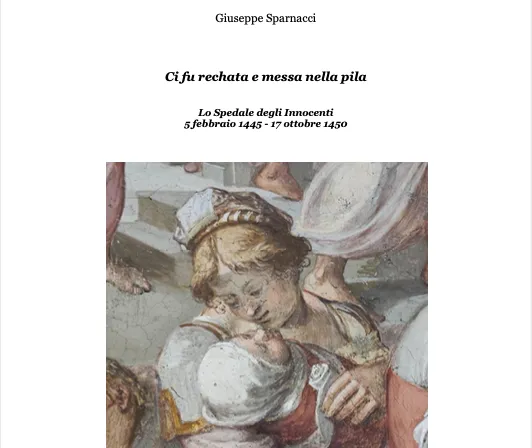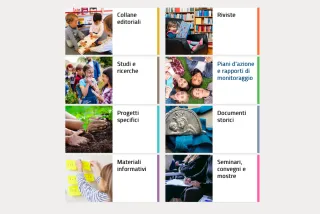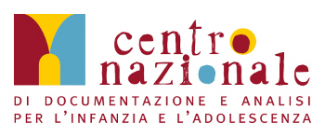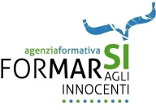The Book by Giuseppe Sparnacci Tells the Story of the Origin of Admission of Children at the Old Hospital
Focus on the first manuscript with entries of newborn babies from 1445
21 March 2024
Area di attività

“Agata e Smeralda à nome la prima fanculla femmina, fu posta al nostro Spedale in venerdi adì v di febraio [1444], a ore xiiij° il dì di sant’Agata. Said she was baptised and placed in the basin. Recholla monna Antonia per suo diritto nome, era chiamata per altro nome monna Giovanna di ***. Rechò co ’ lla detta fanculla 2 quartieri di ghonnellacia bigella153 rotte per pezze lane, 4 pezze lane, 1 pezzuolo di peza lina per in chapo, 2 fasce nuove e non rechò niuno altro sengno chon secho la detta Agata e Smeralda”.
The entry, related to the admission of the first girl at the old Ospedale degli Innocenti, Agata Smeralda, is the first and at the same time the prototype of the entries of the caring activities that the Institute has been carrying out for over six centuries. All the information noted down by the scribes regarding the admission of hundreds of hundreds of thousands of newborn babies is contained in the large manuscript volumes kept in the Historical Archive of the Innocenti. The book Ci fu rechata e messa nella pila (She Was Brought to Us and Placed in the Basin) by Giuseppe Sparnacci, a member of the Institute’s Board of Directors, focuses on the first volume, the one recording the entries from 5 February 1445 to 17 October 1450. The book will be presented in the presence of the author on 25 March at 5pm in the Poccetti Hall of the Istituto degli Innocenti.
The manuscript mentioned in Sparnacci’s book is the first in a long series, called Balie e Bambini (Wet Nurses and Babies), which records the admissions of newborns and continues up to contemporary times. The volumes contain information on the admission of each child and on their fostering with the wet nurses, as well as records of the expenses incurred for care and upkeep. For some, their fate is also noted down: death, return to their parents, their placement with trusted people of the Hospital or their stay at the Hospital after returning from wet nursing.
Giuseppe Sparnacci's book, available at the Bookshop of the Istituto degli Innocenti, contains the transcripts of all the 438 entries related to newborn babies who arrived from 5 April 1445 (Agata Smeralda) to 17 October 1450 (Giovanna Marietta) and details of the contracts with the 32 in-house wet nurses. These first entries were to be followed, over the years and centuries to the present day, by hundreds of thousands more. However, the early years of the Institute's history are particularly interesting from a documentary point of view because of the wide availability of information. This richness was probably due to the great enthusiasm that accompanied the start of the Institute's activities, perhaps due to the still small number of arrivals and the great awareness that the Innocenti was the first Hospital in Florence for abandoned babies. The work, in addition to a thorough bibliographic study, is based on a meticulous investigation of the records concerning all child admissions during the specified period. It is further enriched with information drawn from other contemporary manuscripts produced by the Hospital during this time, such as those documenting when children were admitted and when they left, recollections, and ledgers where all expenses were recorded, along with debtors and creditors. Some specific investigations conducted for this volume highlight lesser-known aspects and novelties. It is interesting, for example, to note the records describing the poverty of the infants’ belongings, using terms that refer to the quality of the cloth and swaddling clothes, often described as miserable, torn, tattered, or wretched. And they often noted down aspects concerning the bodies of the newborns and the conditions in which they arrived: naked and cold or with an untied umbilical cord.
Particular attention is also paid to the role of women in the Innocenti community, including the Maggiore, presumably the female counterpart of the Prior. From the analysis of the first volume of the receptions at the Innocenti, it was possible to determine the list, in chronological order, of the in-house wet nurses, i.e., those women who worked at the Hospital. This list shows that during this period there was always at least one wet nurse available to breastfeed the newborn babies arriving at the Hospital.
Thanks to his analysis of the documents, the author sheds light on the coexistence of the basin and the grated window, which most likely coexisted from the very beginning of the reception activity; but also on the history of the putto and how it immediately became the symbol of the Innocenti.
Last update: 05/09/2025 - 16:48









